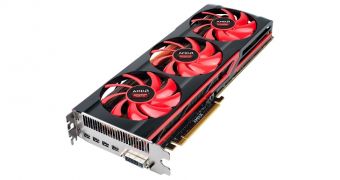It looks like that rumor about AMD's decision to drop the Radeon HD 7990 dual-GPU Malta graphics adapter might turn out to be true after all. It is doubtful that the recent price cut would have happened otherwise.
Advanced Micro Devices definitely scored some points and bragging rights earlier this year, when it released the Radeon HD 7990 video board, codenamed Malta.
After all, with two Tahiti graphics processing units (operating at 950 MHz / 1 GHz Boost) and 6 GB of GDDR5 VRAM (6 GHz clock), it had plenty of resources to go around.
The 288GB/s memory bandwidth and AMD App Acceleration technology were great advantages as well.
What's more, the card ships with eight games, which would normally add another $100 / €100 if they were to be bought separately.
All in all, AMD had enough of a reason to believe the price of $1,100 – $1,200 / €1,100 – €1,200 would work.
Now, however, whether because of the supposed decision to drop the card, or the approach of the Radeon HD 9000 series, the HD 7990 has become cheaper.
You should be able to find it up for online order at $699.99 / €699.99, although some custom models go higher, to $729.99 and $749.99 occasionally, and even $789.99.
Currently, NVIDIA's GeForce GTX 780 sells for $630 – $660 / €630 - €660 on average, so there shouldn't be a reason not to get AMD's product instead. Especially with AMD fixing the CrossFire micro-stutter in the latest driver.
Besides, NVIDIA's doesn't have anything that can match AMD's Never Settle free game bundles either, albeit not for lack of trying.
Needless to say, the GTX Titan might lose a few customers in the near term as well. Sure, it's a single-GPU card with dual-GPU board performance, but it still costs $1,000 / €1,000 on average.

 14 DAY TRIAL //
14 DAY TRIAL //